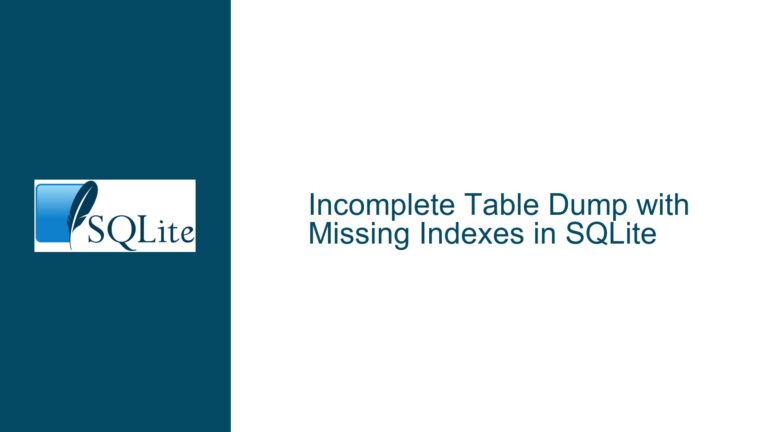Data Race in SQLite Shared Memory Handling Between Threads
SQLite Shared Memory Access Race Condition in Multi-Threaded Environment
In SQLite, shared memory (SHM) is a critical component used primarily for Write-Ahead Logging (WAL) mode to facilitate concurrent read and write operations. A data race condition has been identified in the handling of shared memory structures, specifically involving the pDbFd->pInode->pShmNode pointer. This race condition occurs when two threads attempt to access or modify the shared memory node (pShmNode) concurrently, leading to potential null pointer dereferencing and undefined behavior. The issue manifests in scenarios where one thread is initializing the shared memory node while another thread attempts to access it, both protected by different mutexes. This misalignment in synchronization can result in severe consequences, including application crashes or data corruption.
The race condition is particularly concerning because it involves low-level file descriptor and inode structures in the Unix backend of SQLite. The pShmNode pointer is part of the shared memory node structure, which is essential for managing locks and memory mappings in WAL mode. When one thread assigns a new pShmNode while another thread reads it, the latter may encounter a null pointer if the assignment has not yet completed. This scenario is exacerbated by the fact that the two threads use different mutexes for synchronization: unixEnterMutex() in one thread and sqlite3_mutex_enter(pShmNode->pShmMutex) in the other. This lack of a unified locking mechanism creates a window for race conditions.
The impact of this race condition is significant. If the access in the second thread occurs before the assignment in the first thread, the pShmNode pointer will be null, leading to a null dereference when attempting to access pShmNode->nRef. This can cause the application to crash or behave unpredictably. Furthermore, the race condition undermines the reliability of SQLite in multi-threaded environments, particularly in high-concurrency scenarios where shared memory operations are frequent.
Misaligned Mutex Protection and Global Configuration Oversight
The root cause of this data race lies in the misaligned mutex protection mechanisms and an oversight in the global configuration of SQLite. The two threads involved in the race condition use different mutexes to protect their operations, creating a gap in synchronization. Thread 1 uses unixEnterMutex() to protect the assignment of pShmNode, while Thread 2 uses sqlite3_mutex_enter(pShmNode->pShmMutex) to protect its access to pShmNode. These mutexes are not inherently linked, meaning that changes to pShmNode in Thread 1 are not atomically visible to Thread 2.
Additionally, the race condition highlights a critical requirement for SQLite’s multi-threaded operation: the sqlite3GlobalConfig.bCoreMutex global variable must be set to true. This variable ensures that SQLite’s core operations are thread-safe by enabling the use of mutexes where necessary. However, the fuzz-testing tool used to identify the race condition did not account for this requirement, leading to a false assumption that the race was due to a bug in SQLite rather than a misconfiguration.
The misalignment of mutex protection is further compounded by the fact that the shared memory node (pShmNode) is a shared resource accessed by multiple threads. In a properly configured system, all accesses to pShmNode should be protected by a single, unified mutex to ensure atomicity and visibility across threads. The current implementation, however, allows for partial protection, leaving room for race conditions to occur.
Implementing Unified Mutex Protection and Verifying Global Configuration
To resolve this data race, a unified mutex protection mechanism must be implemented for all accesses to the shared memory node (pShmNode). This involves ensuring that both the assignment and access of pShmNode are protected by the same mutex. One approach is to use the pShmNode->pShmMutex mutex for all operations involving pShmNode, as this mutex is already used in Thread 2. By extending its use to Thread 1, we can eliminate the race condition.
The following steps outline the necessary changes:
Modify
unixOpenSharedMemory()to usepShmNode->pShmMutex: In Thread 1, replace the use ofunixEnterMutex()withsqlite3_mutex_enter(pShmNode->pShmMutex)before assigningpShmNode. This ensures that the assignment is protected by the same mutex used in Thread 2.Verify
sqlite3GlobalConfig.bCoreMutexis set to true: Before initializing SQLite in a multi-threaded environment, ensure that thesqlite3GlobalConfig.bCoreMutexglobal variable is set to true. This can be done by callingsqlite3_config(SQLITE_CONFIG_MULTITHREAD)during application startup.Add assertions to validate mutex usage: Introduce assertions in the code to verify that the correct mutex is held during operations involving
pShmNode. This helps catch any misconfigurations or incorrect mutex usage during development and testing.Conduct thorough testing: After implementing the changes, perform extensive testing to ensure that the race condition is resolved. This includes stress testing in high-concurrency scenarios and using tools like fuzz testers to validate the fixes.
By implementing these changes, the data race condition can be effectively mitigated, ensuring the reliability and stability of SQLite in multi-threaded environments. Additionally, developers should always verify the global configuration of SQLite when using it in multi-threaded applications to avoid similar issues in the future.
Detailed Analysis of the Fixes
Unified Mutex Protection
The core of the issue lies in the inconsistent use of mutexes to protect the shared memory node (pShmNode). In the current implementation, Thread 1 uses unixEnterMutex() to protect the assignment of pShmNode, while Thread 2 uses sqlite3_mutex_enter(pShmNode->pShmMutex) to protect its access. This inconsistency creates a race condition because the two mutexes are not synchronized.
To address this, we need to ensure that both threads use the same mutex for all operations involving pShmNode. The pShmNode->pShmMutex is the most appropriate choice because it is already used in Thread 2 and is specifically designed to protect shared memory operations. By extending its use to Thread 1, we can ensure that all accesses to pShmNode are properly synchronized.
The modification to unixOpenSharedMemory() involves replacing the call to unixEnterMutex() with sqlite3_mutex_enter(pShmNode->pShmMutex). This ensures that the assignment of pShmNode is protected by the same mutex used in Thread 2. Additionally, we need to ensure that the mutex is released after the assignment is complete, using sqlite3_mutex_leave(pShmNode->pShmMutex).
Verifying Global Configuration
The sqlite3GlobalConfig.bCoreMutex global variable is a critical component of SQLite’s thread-safety mechanism. When set to true, it ensures that SQLite’s core operations are protected by mutexes, making them thread-safe. However, if this variable is not set correctly, SQLite may not use mutexes where necessary, leading to race conditions and other thread-safety issues.
To prevent this, developers must ensure that sqlite3GlobalConfig.bCoreMutex is set to true before initializing SQLite in a multi-threaded environment. This can be done by calling sqlite3_config(SQLITE_CONFIG_MULTITHREAD) during application startup. This function configures SQLite to use multi-threaded mode, enabling the necessary mutexes for thread-safe operation.
Adding Assertions for Mutex Validation
Assertions are a powerful tool for catching programming errors during development and testing. By adding assertions to validate mutex usage, we can ensure that the correct mutex is held during operations involving pShmNode. This helps catch any misconfigurations or incorrect mutex usage before they lead to race conditions or other issues.
For example, we can add an assertion in unixOpenSharedMemory() to verify that pShmNode->pShmMutex is held before assigning pShmNode. Similarly, we can add assertions in unixShmSystemLock() to verify that the same mutex is held before accessing pShmNode. These assertions help enforce the correct usage of mutexes and provide early detection of potential issues.
Conducting Thorough Testing
After implementing the changes, it is essential to conduct thorough testing to ensure that the race condition is resolved. This includes stress testing in high-concurrency scenarios, where multiple threads are accessing and modifying the shared memory node concurrently. Additionally, using tools like fuzz testers can help validate the fixes by simulating a wide range of conditions and edge cases.
Stress testing involves creating a test environment where multiple threads perform operations on the same SQLite database concurrently. This helps identify any remaining race conditions or synchronization issues that may not be apparent in single-threaded or low-concurrency scenarios. Fuzz testing, on the other hand, involves generating random inputs and operations to test the robustness of the system. This helps uncover any hidden issues that may not be caught by traditional testing methods.
By following these steps, developers can effectively resolve the data race condition in SQLite’s shared memory handling and ensure the reliability and stability of their applications in multi-threaded environments.






